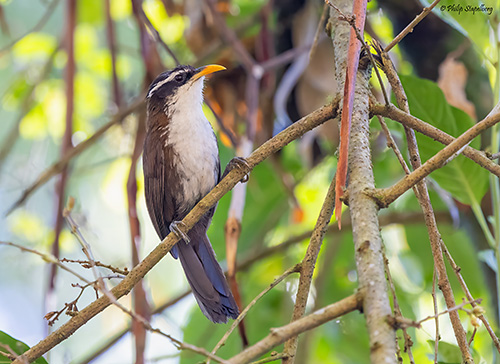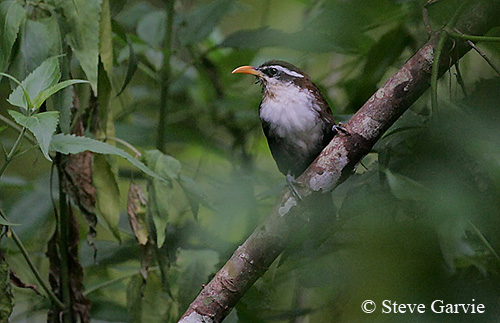
Fr: Pomatorhin de Ceylan
Ang: Sri Lanka Scimitar-babbler
All: Schwarzschwanzsäbler
Esp: Cimitarra cingalesa
Nd: Ceylonese Kruiplijster
Sd: ceylonsabeltimalia
Photographers:
Steve Garvie
RAINBIRDER Photo galleries
Philip Stapelberg
GALLERY
Alan & Ann Tate
AA Bird Photography
Text by Nicole Bouglouan
Sources:
HANDBOOK OF THE BIRDS OF THE WORLD Vol 12 by Josep del Hoyo-Andrew Elliott-David Christie - Lynx Edicions - ISBN: 8496553423
Wikipedia, the free encyclopaedia
Sri Lanka Scimitar-babbler
Pomatorhinus melanurus
Passeriformes Order – Timaliidae Family
INTRODUCTION:
The Sri Lanka Scimitar-babbler is an Old Word babbler endemic to Sri Lanka where two subspecies share the range.
It frequents shady forests with rich understorey vegetation, often near to streams. It favours habitats which provide food resources and cover.
The Sri Lanka Scimitar-babbler feeds primarily on invertebrates, but flower nectar and berries are also part of the diet.
This species lives in pairs or small groups, depending on the season. It is known for its powerful vocalizations, performing both duets and choruses.
During the breeding season, both adults build an untidy domed nest, often placed near the ground and concealed among dense foliage. Both parents share the nesting duties.
The Sri Lanka Scimitar-babbler is described as common in most parts of the range, although it is affected by habitat loss. But currently, the species is not globally threatened.

DESCRIPTION OF THE BIRD:
Biometrics:
Length: 19-21 cm
The Sri Lanka Scimitar-babbler of nominate race has dark rufescent-brown upperparts, but upperwing and graduated tail are duller, mostly dark greyish-brown.
The underparts are white from chin to belly, whereas flanks and thighs are like the upperparts. Lower belly to vent is dull greyish.
On the head, the forehead is blackish and the crown is dark greyish-brown. We can see a conspicuous long, white supercilium extending from the base of the bill above the blackish lores, to the upper side of the neck. Upper cheeks and ear-coverts are blackish, extending and shading to the rufescent-brown neck side. Chin, throat and lower cheeks are white.
The long, decurved and laterally compressed yellow bill is darker around the nostrils.
The eyes are brownish-red.
Legs and feet are greyish-blue, especially the feet. Both are very strong and the claws are long, especially the hind claw.
Male and female are similar.
The juvenile has more rufous on the upperparts, breast sides and flanks, and less white on the underparts.
The head is greyer with straighter bill.
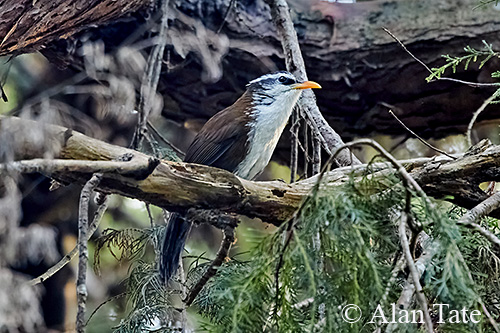
SUBSPECIES AND RANGE:
The Sri Lanka Scimitar-babbler has two subspecies.
P.m. melanurus (described above) is found in humid lowlands and wet hills of the western part of Sri Lanka.
P.m. holdsworthi is found in the dry lowlands and eastern hills of the island.
This one has less rufescent, more yellowish upperparts and flanks than nominate.
HABITAT:
The Sri Lanka Scimitar-babbler frequents shady, deciduous and evergreen forests often near streams, bamboo stands, low-growing jungle vegetation and thick cover. But this species may also be found outside forests, even in well-wooded gardens, if a sufficient cover is available.
The species is visible from sea-level up to 2,100/2,400 metres of elevation.
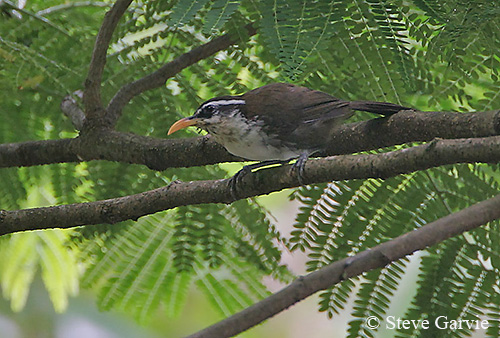
CALLS AND SONGS: SOUNDS BY XENO-CANTO
The Sri Lanka Scimitar-babbler is a sociable species often seen in pairs or small family parties. The characteristics vocalizations include series of loud, melodious notes, clucks, whistles and chirps. These sounds are used as contact and communication between them. Duets and choruses are also part of their repertoire.
In family groups, the male gives some “twoi twoi twoi”, and we can also hear an “oop-oop-oop-oop” and a loud, pleasant “pawp-a-pawp” to which the female responds by “kaa-kree kaa-kree”.
Other sounds are produced such as a descending “do do do do do”, a “pop pop-prrr” and also a deep “woch wohorro”.
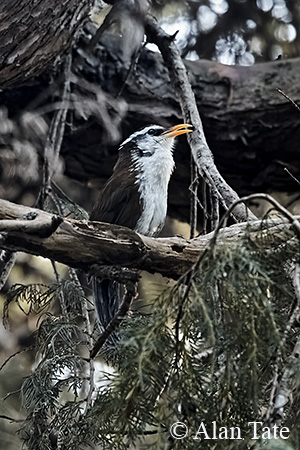
BEHAVIOUR IN THE WILD:
The Sri Lanka Scimitar-babbler is primarily insectivore, feeding on insects, grubs and spiders. But varying amounts of vegetable matter may supplement the diet, including nectar from flowers and also berries.
It forages on the ground in the dense undergrowth. The stout, decurved bill is well adapted from digging and probing in several types of soils. But this species also forages on low branches, vertical trunks and large limbs of trees, by moving like a woodpecker.
The Sri Lanka Scimitar-babbler is often seen in pairs during the breeding season, and in small family groups the rest of the year. It may also join other bird species. It is known as a sociable bird.
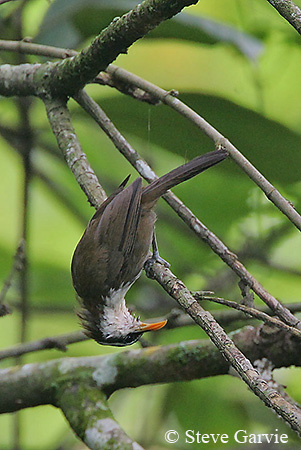
The courtship displays are poorly known, although courtship feeding is reported for several species. Vocalizations also play an important role during the displays.
The nest made of twigs, leaves and grass is usually built in dense shrubs or low bushes, and in tree crevices. Both adults share the nesting duties.
The Sri Lanka Scimitar-babbler is resident in Sri Lanka.
It is essentially terrestrial. The flight can be strong and fast, but only over short distances. It is usually weak, due to the short wings and the graduated tail. The bird flies at low level, a few metres off the ground.
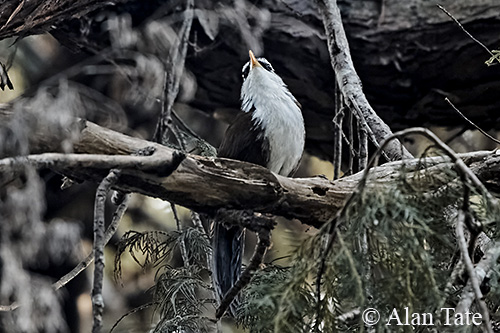
PROTECTION / THREATS / STATUS:
The Sri Lanka Scimitar-babbler is facing threats from natural predators such as large Birds of Prey, snakes and mammals. But it is able to blend into its habitat and it flies quickly over short distances to move away from the danger.
The species is also threatened by habitat loss caused by deforestation, agriculture expansion and urban development.
However, it is described as common and widely distributed in lowlands, but mainly in the hills.
The size of the population is unknown, but it is suspected to be declining.
However, the Sri Lanka Scimitar-babbler is not globally threatened and the species is currently evaluated as Least Concern.
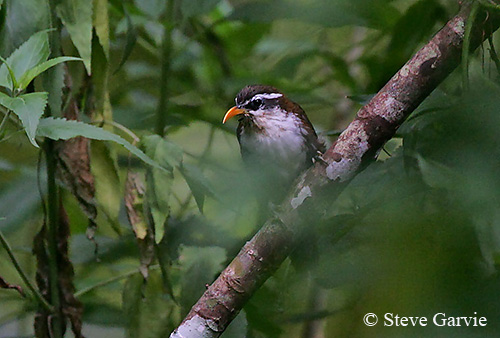
REPRODUCTION OF THIS SPECIES:
The breeding season takes place during the monsoon season, between May and July in SW of the island, when both vegetation and food resources are abundant. Other sources report a breeding season from December to January.
Generally, both sexes of babbler species take part in parental duties including nest-building, incubating the eggs and rearing the chicks.
The nests are often cup-shaped and made of twigs, moss, rootlets, grass, plant fibres and dead leaves. It may be built in tree-crevice or sometimes on rocky ledges, but more often in dense shrubs and low bushes. The nests built close to the ground tend to be domed with an entrance on the upper side.
The female lays 3-5 white eggs and both adults share the incubation and rear the chicks. While begging for food, the chicks give some plaintive mewing.
No more information.
